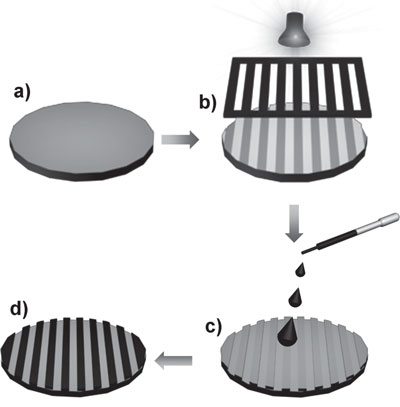| Posted: Jun 10, 2013 | |
Cheap nanotechnology paper-based gas sensors |
|
| (Nanowerk Spotlight) Nanotechnology-enabled, paper-based sensors promise to be simple, portable, disposable, low power-consuming, and inexpensive sensor devices that will find ubiquitous use in medicine, detecting explosives, toxic substances, and environmental studies (see for instance: "Simple nanotechnology paper sensor for detecting toxins in water" and "Biosensors printed on bioactive paper"). | |
| Great efforts have been devoted to exploiting semiconductor based sensors, ranging from one-dimensional wires to two-dimensional arrays or films. Since monitoring needs for environmental, security, and medical purposes are growing fast, the demand for sensors that are low cost, low power-consuming, high sensitivity, and selective detection is increasing as well. Because it is easily available, low-cost, insulating, flexible, and portable, paper has been recognized as a particular class of supporting matrix for accommodating sensing materials. However, methods for depositing semiconductor materials with high stability and continuity on papers are still sparse. | |
| A team of Chinese researchers has now developed low-cost gas sensors by trapping single-walled carbon nanotubes (SWCNTs) in paper and demonstrated their effectiveness by testing it on ammonia. They reported their findings in the May 13, 2013 online edition of Small ("Forced Assembly of Water-Dispersible Carbon Nanotubes Trapped in Paper for Cheap Gas Sensors"). | |
| "We developed a suction filtration method – which is commonly used in chemistry labs – to successfully deposit SWCNTs on paper," Yapei Wang, a Professor of Chemistry at Renmin University of China, tells Nanowerk. "Deposition of SWCNTs is just a start, and we will try other semiconductor materials as well. As the air pollution in our local city is becoming more serious, we are encouraged even more to exploit cheap sensors that can be extensively used like for instance pH and glucose test papers." | |
| By using a common suction filtration method, water-dispersible SWCNTs were sucked into porous filter paper to be assembled there. Wang notes that the porous paper was fully filled with SWCNTs, which were were well distributed through the paper, affording robust sensing arrays with the same thickness as the paper. | |
 |
|
| Schematic illustration of preparation of SWCNT-based paper sensors: a) A filter paper coated with photoresist; b) selective crosslinking of photoresist; c) suction filtration of SWCNTs through the paper under low pressure; d) a paper chip with sensing arrays. (Reprinted with permission from Wiley-VCH Verlag) | |
| The team then fabricated sensors with the SWCNT-impregnated paper by cutting it into small pieces and depositing gold electrodes on it. | |
| "Detection sensitivity routinely relies on how fast the gas comes into contact with the SWCNTs and how much the SWCNT responds to the adsorbed gas molecules," explains Wang. "The former is a physical diffusion process which is affected by the size of sensing area and surface chemistry of SWCNTs. A larger sensing area can allow more gas molecules to contact the SWCNTs. Our tests indicated that thinner arrays afforded a stronger response to ammonia gas at a concentration of 20 ppm than did the thicker arrays." | |
| He notes that a similar rule also applies to the sensing arrays with the same feature width but different line numbers – an increase of array number depressed the sensitivity of the sensor. | |
| The paper sensors developed in this work can be integrated into a common electric circuit, performing a similar function than traditional analytical equipment that is huge and hard to carry. Wang also stresses the environmental impact of paper chips: Cellulose, the raw material for paper, is a renewable product. And by using paper instead of plastic chips there will be less environmental impact from nonbiodegradable waste. | |
| Estimating the cost of their paper-based gas-sensing chips, including all material, equipment usage, energy and labor cost, the team estimates a total price of below $1 per sensor chip. | |
| "We believe that our approach offers a generally applicable approach for integrating active nanomaterials into paper matrices, opening opportunities in flexible sensors and optoelectronics strategies," says Wang. | |
| While this sensor works with ammonia, detection of some other gases broadly found in polluted air is also of vital importance. This may be accomplished by stepwise implantation of multiple detectors in a paper chip. | |
| "However" says Wang, "the challenge of synchronous gas detection and elimination still remains. It is possible for paper chips to act as an antenna to recognize the target gas, deliver the information, and then catch, even eliminate, the toxic gas. We hope this work will open the door to new, exciting applications of paper chips." | |
 By
Michael
Berger
– Michael is author of three books by the Royal Society of Chemistry:
Nano-Society: Pushing the Boundaries of Technology,
Nanotechnology: The Future is Tiny, and
Nanoengineering: The Skills and Tools Making Technology Invisible
Copyright ©
Nanowerk LLC
By
Michael
Berger
– Michael is author of three books by the Royal Society of Chemistry:
Nano-Society: Pushing the Boundaries of Technology,
Nanotechnology: The Future is Tiny, and
Nanoengineering: The Skills and Tools Making Technology Invisible
Copyright ©
Nanowerk LLC
|
|
|
Become a Spotlight guest author! Join our large and growing group of guest contributors. Have you just published a scientific paper or have other exciting developments to share with the nanotechnology community? Here is how to publish on nanowerk.com. |
|
